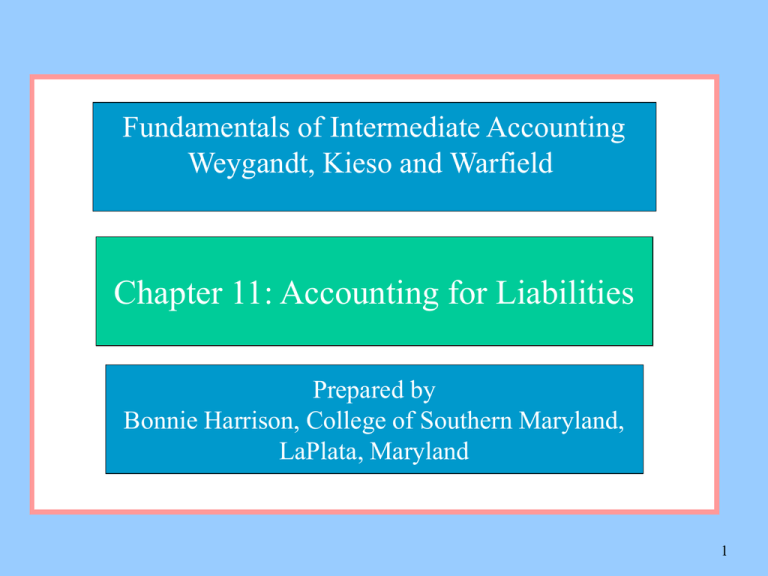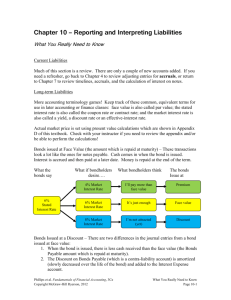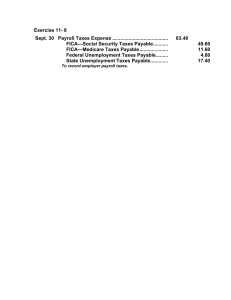
Fundamentals of Intermediate Accounting
Weygandt, Kieso and Warfield
Chapter 11: Accounting for Liabilities
Prepared by
Bonnie Harrison, College of Southern Maryland,
LaPlata, Maryland
1
Chapter 11
Accounting for Liabilities
1
2
3
4
After studying this chapter, you should be able to:
Describe the nature, type and valuation of current
liabilities.
Identify various types of bond issues.
Describe the accounting valuation of bonds at date of
issuance.
Describe the accounting for the extinguishment of
debt.
2
Chapter 11
Accounting for Liabilities
5
6
7
8
After studying this chapter, you should be able to:
Identify the criteria used to account for and disclose
gain and loss contingencies.
Explain the accounting for different types of loss
contingencies.
Explain the reporting of off-balance-sheet financing
arrangements.
Indicate how liabilities and contingencies are
presented and analyzed.
3
Liabilities in General
Liabilities are:
probable future sacrifices of economic
benefits
arising from present obligations
to transfer assets or to provide services in the
future
as a result of past transactions or events
4
Current Liabilities
Current liabilities are:
obligations whose liquidation is
reasonably expected to require
the use of current assets or the creation
of other current liabilities
5
Typical Current Liabilities
Accounts Payable
Notes Payable
Current maturities of
long term debt
Dividends Payable
Unearned Revenue
Sales Tax Payable
Employee-related
liabilities
Income Tax Payable
6
Notes Payable
Notes payable may be interest-bearing or noninterest-bearing
For non-interest-bearing notes, the difference
between the present value of the note and the
face value of the note represents the discount on
the note payable.
The discount is the interest expense chargeable to
future periods
7
Current Maturities of Long Term Debt
The portion of long term debt maturing within the
next fiscal year is reported as a current liability
Long-term debts should not be reported as current
liabilities if:
they are retired by assets not classified as current
assets
they are refinanced by new issues of debt
they are converted into capital stock.
8
Long-Term Debt: General
Long term debt consists of probable future
sacrifices.
It has various covenants or restrictions for the
protection of both lenders and borrowers.
The indenture or agreement incorporates the terms
of the issue and restrictions.
9
Issuing Bonds
Bonds are the most common type of long term debt.
They are usually issued in denominations of $1,000.
A bond indenture is a promise (by the lender to the
borrower) to pay:
•
•
a sum of money at the designated date, and
periodic interest at a stipulated rate on the face value
A bond issue may be sold:
•
•
either through an investment banker, or
by private placement
10
Select Types of Bonds
Secured : bonds secured by collateral (real estate,
stocks
Unsecured bonds (debenture): not backed by collateral
Serial bonds: mature in installments
Term bonds: mature on a single date
Callable bonds: gives issuer right to call and retire
debt prior to maturity
Convertible bonds: can be converted into other
corporate securities for a specified time after
issue
Bearer bonds: are freely transferable by current owner
11
Bond Issues: Parties to the Contract
lend cash
Issuer of Bonds
Bondholders
1. Bond Certificate
2. Periodic interest
3. Redemption of Face Value
12
Valuation of Bonds:
Determining Bond Prices
The price of a bond issue is determined by:
the present value of the annuity of interest payments
(at the contractual rate of interest), and
the present value of the redemption (face) value,
both discounted at the market rate of interest at
issue date.
Interest payments by borrower are calculated as:
Face value of bond issue * contractual interest rate
(as specified in the bond indenture)
13
Valuation of Bonds: Determining Bond
Prices - Example
Given:
Face value of bond issue:
$100,000
Term of issue:
5 years
Contractual interest rate:
9% per year, payable
annually end of the year
Market rate of interest:
11%
Determine the issue price of the bonds.
14
Valuation of Bonds: Determining Bond
Prices - Cash Flows
Year 1
interest $9,000
Year 2
$9,000
Year 3
$9,000
Redemption at maturity ==>
Year 4
Year 5
$9,000
$9,000
$100,000
face value
Interest = $100,000 * 9% per year contractual rate
15
Valuation of Bonds: Determining Bond
Prices - Present Value of Cash Flows
Year 1
interest $9,000
$ 33,262
plus
$ 59,345
Year 2
Year 3
$9,000
$9,000
Year 4
$9,000
Year 5
$9,000
Discount at market rate, 11%
$9,000 * 3.69590
Discount at market rate, 11%
$100,000 * 0.59345
$100,000
=$92,607 is the issue price
16
Bond Issue Pricing: Concept
Relationship
between
contractual rate
and market rate
Relationship
between
Issue Price
and Face Value
Rationale
CR = Mkt Rate
Issue Price = F.V
Market rate is the
same as Bond rate
CR < Mkt Rate
Issue Price < F.V.
Issuer offers a
discount to b/holder
to compensate for
lower bond interest
CR > Mkt Rate
Issue Price > F.V.
Issuer gets a
premium for
higher bond interest
17
Discount on Bonds Payable: Concept
The discount is amortized (spread over the bond
term) either by the straight line method or the
effective interest method.
The amortized discount on bond issue is added to
the interest paid in cash during the interest period.
Interest expense is recognized as follows:
Cash paid for interest:
$XXX
Add: Discount amortized:
$XXX
Interest expense recognized:
$XXX
18
Premium on Bonds Payable: Concept
The premium is amortized (spread over the bond
term) either by the straight line method or the
effective interest method.
The amortized premium on bond issue is subtracted
from the interest paid in cash during the interest
period.
Interest expense is recognized as follows:
Cash paid for interest:
$XXX
Less: Premium amortized:
$XXX
Interest expense recognized:
$XXX
19
A Note on Amortization Methods
The straight line method allocates the same
amount of discount (or premium) to each
interest period.
The effective interest method allocates the
discount or premium in increasing amounts
over the bond term (see following examples)
However, the total discount or premium
amortized is the same under both methods.
20
Bonds Issued at Par on Interest Date
Given: (Fiscal year is calendar year)
Face value of bonds issued:
$100,000
Issue Price:
$100,000
Market Rate:
10%
Contractual Rate:
10%
Date of issue:
January 1, 2003
Interest dates:
July 1 and Jan 1
Give the journal entries for issue and payment of
interest.
21
Bonds Issued at Par on Interest Date
January 1, 2003 (Issue):
Cash
Bonds Payable
$100,000
$100,000
July 1, 2003 (Interest Payment):
Interest Expense
$ 5,000
Cash
December 31, 2003 (Interest Accrual):
Interest Expense
$ 5,000
Interest Payable
$ 5,000
$ 5,000
22
Bonds Issued at a Premium on Interest Date:
Straight Line Amortization
Given: (Fiscal year is calendar year)
Face value of bonds issued:
$ 100,000
Issue Price: (issue at 108.53)
$ 108,530
Market Rate:
6%
Contractual Rate:
8%
Date of issue:
January 1, 2003
Interest dates:
July 1 and Jan 1
Term of issue:
5 years
Give the journal entries for issue and interest payment.
23
Bonds Issued at a Premium on Interest Date:
Straight Line Amortization
January 1, 2003 (Issue):
Cash
$108,530
Bonds Payable
Premium on Bonds Payable
$100,000
$ 8,530
July 1, 2003 (Interest Payment):
Interest Expense
$ 3,147
Premium on Bonds Payable
$
853
Cash
$ 4,000
Note: Premium amortized = $ 8,530 / 10 payments = $ 853
24
Bonds Issued at a Discount on Interest Date:
Straight Line Amortization
Given: (Fiscal year is calendar year)
Face value of bonds issued:
$ 100,000
Issue Price:
$ 92,278
Market Rate:
10%
Contractual Rate:
8%
Date of issue:
January 1, 2003
Interest dates:
July 1 and Jan 1
Term of issue:
5 years
Give the journal entries for issue and interest payment.
25
Bonds Issued at a Discount on Interest Date:
Straight Line Amortization
January 1, 2003 (Issue):
Cash
Discount on Bonds Payable
Bonds Payable
$ 92,278
$ 7,722
$100,000
July 1, 2003 (Interest Payment):
Interest Expense
$ 4,772
Discount on Bonds Payable
$
772
Cash
$ 4,000
Note: Discount amortized = $ 7,722 / 10 payments = $ 772
26
Classification of Discount on Bonds Payable
Discount on bonds payable is a contra
liability account and is shown as:
Bonds Payable (face value) :
$ XXX
less: Unamortized Discount : ($ XX)
Bonds Payable (carrying value): $ XXX
27
Classification of Premium on Bonds Payable
Premium on bonds payable is an adjunct
account and is shown as:
Bonds Payable (face value) :
$ XXX
Add: Unamortized Premium : $ XX
Bonds Payable (carrying value): $ XXX
28
Extinguishment of Debt
When debt is extinguished (paid),
any premium or discount on bond issue
must be amortized up to the date of
extinguishment, and
any bond issue costs must be amortized up
to date of extinguishment.
29
Extinguishment of Debt: Example
Given:
Existing debt:
Called and canceled at
Unamortized discount:
Unamortized bond issue costs:
$800,000
$808,000
$ 14,400
$ 9,600
Note: Both discount and bond issue costs have been
amortized up to the date of cancellation of debt.
Give the journal entry for the extinguishment.
30
Extinguishment of Debt: Example
Bonds Payable
$800,000
Loss on Extinguishment
$ 32,000
Discount on Bonds
$ 14,400
Unamortized Bond Issue
Costs
$ 9,600
Cash
$ 808,000
Note: The loss is a balancing figure and is recognized
currently in income in period of redemption.
31
Contingency: Definition
A contingency is:
•
an existing condition, situation, or set of
circumstances
•
involving uncertainty as to
•
possible gain (gain contingency) or
•
loss (loss contingency)
•
that will ultimately be resolved
•
when one or more future events occur or
•
when such event or events fail to occur
32
Gain Contingencies
Gain contingencies are claims or rights to receive
assets, which may become valid eventually.
Examples are:
Possible receipts of monies from gifts, donations,
bonuses, etc.
Pending litigation whose probable outcome is
favorable
Possible tax refunds in tax disputes
Gain contingencies are not accrued (conservatism)
33
Loss Contingencies: General
Loss contingencies involve situations of possible
•
•
•
loss.
A liability incurred as a result of a loss contingency
is a contingent liability
The likelihood of occurrence of the event may be:
remote (slight)
reasonably possible (more than remote but less
than likely)
probable (likely)
34
Loss Contingencies: Accrual
Estimated losses from loss contingencies are accrued
as liabilities if:
•
it is probable that a liability has been incurred,
AND
•
the amount of loss can be reasonably estimated
It is not necessary that the exact payee or the exact
date of payment need be known.
The interpretation of the three terms (probable to
remote) is based on lawyers’ responses.
35
Litigation, Claims, and Assessments
To determine whether a liability should be
recorded, evaluate:
1.
2.
3.
the time period in which the underlying cause of action
occurred
the probability of an unfavorable outcome
the ability to make a reasonable estimate of loss
To determine the probability of outcome, evaluate:
1.
nature of litigation and progress of case
2.
opinion of legal counsel
3.
response by management
36
Guarantee and Warranty Costs
A warranty is a promise made by a seller to a buyer
to make good on a deficiency (of quantity or quality)
Warranties entail future “post-sale costs”
Under the cash basis method, warranty costs are
charged to the period in which the costs are paid
Under the accrual basis method:
warranty costs (for warranties sold with the product) are
estimated and matched with revenue
extended warranty revenues are deferred and recognized over
the life of the warranty contract (sales warranty
approach)
37
Guarantee and Warranty Costs: Example
Given:
units sold in 2003: 10,000 units at $300
expected return rate for repair: 3%
expected repair cost per unit: parts, $5; labor, $10
units returned in 2004: 170 units.
Actual repair costs: same as estimated
The entity has the calendar year as its fiscal year.
Record the warranty expense for 2003.
38
Manufacturer’s Warranties
Estimated warranty costs:
3% of 10,000 units at $15 each = $4,500
Adjusting journal entry (Dec 31, 2003):
Warranty Expense
$4,500
Estimated Liability
under Warranties
$4,500
Entry in 2004: (170 units at $15 each)
Estimated Liability (warranties)
$ 2,550
Parts Inventory
$ 850
Wages Payable
$1,700
39
Extended Warranties:
Example
Refer to the previous example.
Assume that the seller sold extended warranties on
the 4,000 units as follows:
$30 per unit for years 2005 and 2006.
Record the sale in 2003 and show recognition of
warranty revenue in 2005.
40
Extended Warranties: Example
Journal entry in 2003:
Cash
$3,120,000
Sales Revenue
$3,000,000
Unearned Warranty Revenue
$ 120,000
Journal entry in 2005: (relating to year 2003 sales)
Unearned Warranty
Revenue $ 60,000
Warranty Revenue
$ 60,000
(1/2 of deferred revenue now recognized)
41
Environmental Liabilities
Environmental liabilities represent estimated costs to
clean-up waste and toxic sites.
Currently, companies provide only disclosures
without accruing any liabilities: they argue that best
estimates are not feasible.
The SEC argues that the companies should accrue
the minimum expected cost (absent a best estimate).
Environmental liabilities should be reported in the
balance sheet independent of recoveries from third
parties.
42
Off Balance Sheet Financing
Off balance sheet financing represents borrowing
arrangements that are not recorded.
The amount of debt reported in the balance sheet
does not include such financing arrangements.
The objective is to improve certain financial ratios
(such as debt-equity ratio)
In project financing arrangements, companies form
a new special purpose entity and borrow through
that entity.
The debt appears on the books of the new entity, and
not on those of the parent companies.
43
Presentation of Liabilities
Current
–
Liabilities
The first classification, commonly listed in
order of maturity, descending amount, or
liquidation preference
Long Term
–
Debt
Frequently one amount reported with
supporting comments and schedules in
accompanying notes.
44
Presentation of Loss Contingencies
If loss contingency is probable AND estimable
record loss contingency and liability.
If loss contingency probable OR estimable (but
not both), and there is reasonable possibility that it
will occur, disclose in the notes:
Nature of contingency
An estimate of loss or range of loss
45
Presentation of Other Contingencies
Certain contingencies should be disclosed
even though loss may be remote. These
include:
Guarantees
of indebtedness
Obligations to bankers under “stand by letters
of credit”
Guarantees to repurchase receivables that have
been sold or assigned
46
Copyright
Copyright © 2003 John Wiley & Sons, Inc. All rights
reserved. Reproduction or translation of this work
beyond that named in Section 117 of the 1976 United
States Copyright Act without the express written
consent of the copyright owner is unlawful. Request
for further information should be addressed to the
Permissions Department, John Wiley & Sons, Inc.
The purchaser may make back-up copies for his/her
own use only and not for distribution or resale. The
Publisher assumes no responsibility for errors,
omissions, or damages, caused by the use of these
programs or from the use of the information
contained herein.
47








